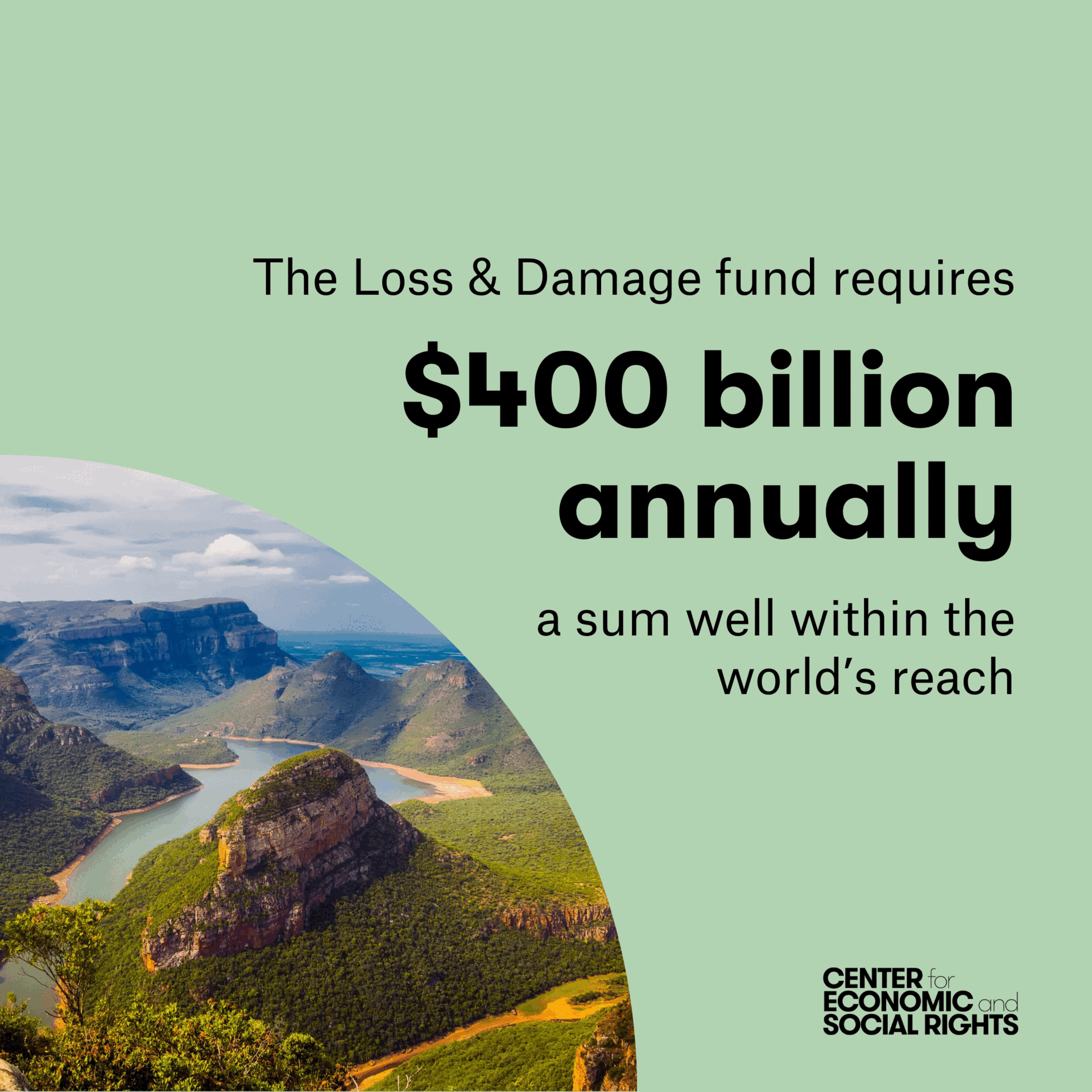This short recap on the state of play in climate finance summarizes a few of the latest developments in the field through a reparations-based framework. Even though recent actions have fallen short of human rights obligations and principles, developing countries and civil society organizations are taking steps to offer hope that climate justice is possible.
By Matthew Forgette, CESR’s Post-graduate Fellow, and Alina Saba, CESR Program Officer
Following monsoon flooding that left more than 1,300 people dead and one-third of Pakistan under flood waters, Pakistan’s climate minister Sherry Rehman made the following observation regarding the global climate crisis: “Global warming is the existential crisis facing the world and Pakistan is ground zero--yet we have contributed less than 1% to [greenhouse gas] emissions…there is so much loss and damage with so little reparations…that obviously the bargain made between the global north and the global south is not working.” Rehman’s comments underscore the fundamental reality that the climate crisis is also a crisis of inequality, and global south nations have suffered the majority of climate disasters without receiving the necessary support. This blog from CESR analyzes the state of global climate financing from a reparations-based lens, seeking to explore ways in which the response to the climate crisis can be conducted in a more just manner aligned with human rights.
The biggest news to arise post-COP28 is the formal adoption of the Loss and Damage fund. The fund is essentially a pool of money made up of contributions from wealthier Global North states intended to remedy the impacts of climate change that are not addressed by mitigation, adaptation, or other measures. Specifically, it is designed to aid vulnerable communities that are coping with ongoing climate disasters.
Developing countries in the Global South face the brunt of climate hazards, and by 2050 studies have estimated that the economic cost of loss and damage to these countries will exceed USD $1 trillion. This figure does not even account for non-economic damage, such as loss of lives and displacement. Thus, the adoption of the Loss and Damage Fund signifies a welcome first step towards a climate justice movement grounded in reparations, meaning that developed Global North states contribute to the Fund, which then distributes the funding to Global South countries that are in greater need.
A reparations-based framework is imperative for a fair climate finance movement because climate change's causes and impacts are so disparate. The logic for this is simple: wealthy Global North states and multinational corporations have been largely responsible for the creation of the climate crisis and, thus, are obliged to address it. This reasoning is enshrined in customary international law. The polluter pays principle and the principle of common but differentiated responsibilities established by the 1992 UN Rio Declaration state that those who produce higher carbon emissions should bear a greater portion of the costs for managing their deleterious effects. These principles are further enshrined in the Paris Agreement, recognizing climate change is a global problem that not all states are equally responsible for causing (and may not have equal capacities to address). Additionally, researchers have recently begun to quantify the precise sum of monetary reparations necessary to ensure a just green transition. A 2023 report published in the journal Nature Sustainability posited that high-carbon emitting states owe at least $192 trillion USD to low-polluting states in compensation.
The Loss and Damage Fund still falls far short of a sufficient reparations-based solution. First, it was determined at COP28 that the fund would be initially managed by the World Bank, an organization that former UN Special Rapporteur on extreme poverty and human rights Philip Alston described in a report as “a human rights-free zone.” Indeed, the plan for managing the fund was bereft of references to human rights and will likely entail private capital contributions (given the World Bank’s recent touting of private-sector solutions like Rwanda’s “sustainability-lined bond”). Most critically, higher-income states' initial contributions to the Loss and Damage Fund were grossly inadequate. The $700 million pledged at the conference might sound impressive until one realizes it pales compared to the $7 trillion in global fossil fuel subsidies granted by states in 2022.
One method that would raise more than enough revenue for the fund is straightforward. A tax of merely 1.5% on individuals possessing more than $100 million would levy nearly $300 billion annually. Other studies have shown that wealth taxes could raise up to $1.2 trillion per year in Europe alone. The justification for this type of tax is also straightforward. A recent report found that from 1990 to 2019, the wealthiest 10% of individuals were responsible for producing more than half of global carbon emissions.
Moving forward, 2024 will be a critical year for climate financing, with financing for loss and damage being integral to that struggle. Initial reports indicate that contributions to the loss and damage fund will be mandatory for higher-income nations. This aligns with the human rights principles noted above that recognize the heightened responsibility of high-income fossil fuel-producing nations. Actors in the climate justice movement should also continue to advocate for the Loss and Damage fund to be as accessible to developing nations as possible and for funds to be distributed via grants rather than loans to avoid exacerbating the debt crisis of lower-income countries.
The Inaugural Global Stocktake
Another item at the top of the climate finance agenda is the first Global Stocktake (GST), a process where, every five years, countries evaluate their progress towards climate goals. The GST has represented a battleground for states to clash over their assessment of the current landscape of climate response.
Indeed, a statement by COP28 President, Al Jabar, symbolized the opening volley in one bitter battle regarding the language used in the GST. Specifically, countries sparred over how to articulate plans pertaining to the future of fossil fuels. More than 100 of the 198 attending countries called for fossil fuels to be “phased out.” The language “phase out” is specific and important because it requires a complete shift away from fossil fuels. Many high-income countries and oil corporations advocated for the use of “phase down,” signaling a gradual tapering of fossil fuel use without a fixed timeline or recognition that fossil fuel use must cease.
The final text of the GST called for a “transition away” from fossil fuels. While this is significant, as it marks the first time a commitment to moving away from fossil fuels was captured within the text of an agreement, it falls short of what is needed to combat the climate crisis. As expressed by Samoa representative, Anne Rasmussen, speaking on behalf of small island states, “We have come to the conclusion that the course correction that is needed has not been secured. We have made an incremental advancement over business as usual, when what we really need is an exponential step change in our actions.”
Ultimately, the most significant finding coming from the GST was that the current response to the climate crisis is lacking. In its final language, the GST “notes with deep regret that the goal of developed country parties to mobilize jointly USD 100 billion per year by 2020…was not met in 2021,” and it “welcomes the ongoing efforts of developed country parties towards achieving the goal of mobilizing jointly USD 100 billion per year.” This finding represents a hard-won victory for developing countries, which sought to guarantee that the GST accurately reflects that climate goals have not been met. Meaningful changes must be made to achieve future goals.
The increasing role of MDBs and private funding in resourcing climate finance

The presence of Multilateral Development Banks (MDBs) in the climate finance space has been made loud and clear as the heads of seven MDBs and the International Monetary Fund (IMF) recently announced the partnership for ambitious climate action and to unlock USD 180 billion in climate finance. World Bank (WB) president Ajay Banga announced that the climate finance target of WB will increase by 45% by 2025 (USD 40 billion in climate finance annually). Bigger, better, bolder MDBs is the key principle of the COP28 UAE Declaration on Global Climate Finance Framework launched by the UAE. It echoed the similar message set by the New Financing Pact Summit of “transforming international financial architecture” to make it fit for the purpose of financing climate action and development. In reality, this is limited to strengthening the same old financial institutions and promoting market-based mechanisms such as unlocking private sector finance, using public finance for de-risking approaches, and scaling carbon markets. It is evident that developed countries and MDBs are working headstrong toward scaling private sector finance for climate action. Despite this, they have continually failed to deliver the meager 100 billion climate finance goal annually by 2020, despite the political commitments made in 2009.
As noted above, the World Bank has a track record of funding fossil fuel projects and violating human rights. Similarly, their proposed ideas, such as debt for nature swaps, have been found ineffective for reducing countries' indebtedness and increasing fiscal space for climate action. Therefore, the rising role of MDBs in climate action must be taken cautiously.
Climate Finance and the UN Tax Convention
Another new and exciting movement in the climate finance space has been the push to recognize the intersection of climate finance and global tax reform, specifically in the context of the upcoming UN Tax Convention (UNTC). Recently, CESR contributed to, and signed, a joint submission to the Convention’s Ad-Hoc Committee stressing the need for climate mainstreaming in the Convention’s terms of reference. There are several ways in which the Convention can be valuable for climate justice.
First, there is a clear linkage between tax policies and climate justice. Article 2.1(c) of the UN Framework Convention on Climate Change establishes that all financial flows should be “consistent with a pathway towards low greenhouse gas emissions and climate-resilient development,” as well as the doctrine of common but differentiated responsibilities mentioned above. Thus far, current climate-related taxation efforts have fallen short of this obligation, specifically the EU’s recent Carbon Border Adjustment Mechanism (CBAM), which has harmed developing countries and vulnerable economies.
Second, the Convention can and should address the need to curb illicit financial flows arising from activities harmful to biodiversity and the environment. In particular, unreported and unregulated fishing accounts for an estimated annual Illicit financial flow of US $23.5 billion, mainly from Global South countries into consumer markets, often in the Global North. Simultaneously, illegal logging accounts for up to $US 152 billion in lost resources, and illegal wildlife trade up to US$23 billion.
Finally, human rights obligations establish a responsibility for states to create taxes that impact mitigating or adapting to climate change. Specifically, the International Covenant on Economic, Social and Cultural Rights Art. 12(2)(b) directs states to adopt measures necessary for the “improvement of all aspects of environmental and industrial hygiene” to fully realize the right to health. This is additionally bolstered with several recommendations from the Financial Integrity for Sustainable Development report, as well as the UN’s own recognition in UN General Assembly reports of “the right to enjoy a clean, healthy, and sustainable environment.”
Essentially, the UN Tax Convention offers a more democratic space for country inputs and a framework for climate finance through progressive taxation, in accordance with what Global South countries have long advocated for.
Ultimately, the outcome of these key issues in climate finance will depend on the how civil society works to together to combat the climate crisis. A substantive process can be seen through the operationalization of the Loss and Damage Fund and the fight to include climate language in the UN Tax Convention’s terms of reference. Moving forward, CESR and its partners seek to build on this progress to create the transformative change necessary to serve best those worst off in the face of this planetary crisis.

